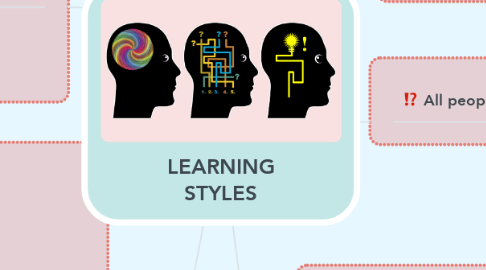
1. Multiple intelligences
1.1. Logical-mathematical intelligence
1.2. Visual-spatial intelligence
1.3. Linguistic-verbal intelligence
1.4. Visual-spatial intelligence
1.5. body-kinesthetic intelligence
1.6. Musical intelligence
1.7. Intrapersonal intelligence
1.8. Naturalistic intelligence
1.9. Interpersonal intelligence
2. Learning models
2.1. Models
2.1.1. Representation system (PNL model)
2.1.1.1. Kinesthetic
2.1.1.2. Visual
2.1.1.3. Auditory
2.1.2. Information processing (Honey and Mumford)
2.1.2.1. Active
2.1.2.2. Reflexive
2.1.2.3. Pragmatic
2.1.2.4. Theoretical
2.1.3. Bipolar category (Felder and Silverman)
2.1.3.1. Sensory / Intuitive
2.1.3.2. Visual / Verbal
2.1.3.3. Sequential / Global
2.1.3.4. Active / Reflective
2.1.4. Learning Agent (David A. Kolb)
2.1.4.1. Convergent
2.1.4.2. Divergent
2.1.4.3. Assimilator
2.1.4.4. Usher
3. All people do not learn the same
3.1. learning has different aspects
3.1.1. Motivation, progressive culture, age, environmental factors, among others.
4. Learning styles
4.1. Visual
4.1.1. They prefer: read, assimilate images, details learn faster.
4.1.1.1. Their learning is based on summarizing, outlining, underlining, writing, and taking notes.
4.1.1.2. Diagrams, photos, movies, encyclopedias, brochures
4.2. Auditory
4.2.1. It is more related to speaking and listening
4.2.1.1. Songs, slides, mobiles, videos, recordings.
4.2.1.2. they learn with oral explanations,
4.3. Kinesthetic
4.3.1. Learn by playing and doing
4.3.2. sensations and movement, draw, relate
4.3.2.1. Strategies: clay, plasticine, pieces, crosswords, board games, maps,
